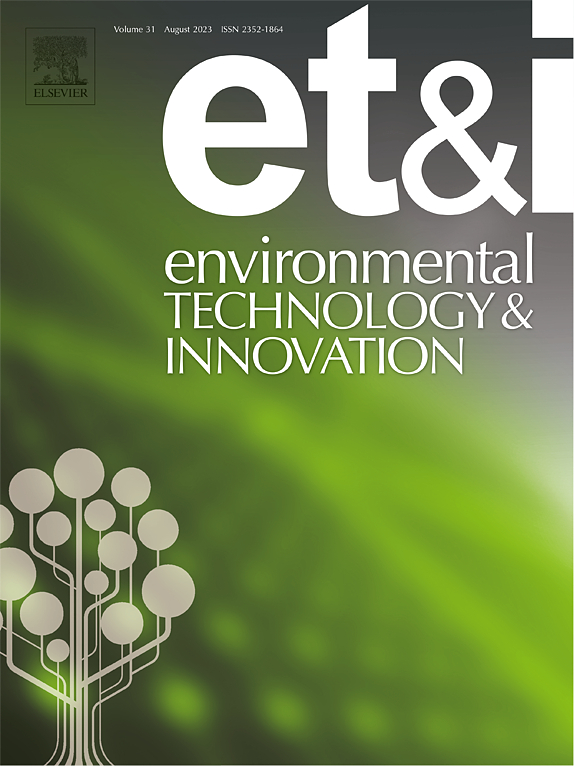Waste to wastewater treatment: Graphene quantum dots embedded poly(ethylene terephthalate) membranes for efficient phenol removal
IF 6.7
2区 环境科学与生态学
Q1 BIOTECHNOLOGY & APPLIED MICROBIOLOGY
引用次数: 0
Abstract
Efficient waste management strategies are essential for addressing environmental degradation and advancing sustainable development. Utilizing waste materials in wastewater treatment presents a promising avenue toward this goal. This study investigates the use of waste carton paper and waste plastic bottles in composite membranes for treating wastewater containing phenol as a contaminant. It introduces a unique approach by utilizing waste carton paper as a bio-source for the synthesis of graphene quantum dots (GQDs) and incorporating them as nanofillers in polyethylene terephthalate (PET) membranes derived from recycled plastic bottles. Furthermore, this study addresses the performance and stability of GQDs-PET membranes for smaller dissolvable organics such as phenol in semi-pilot UF systems. An array of characterizations was performed to confirm the successful application of waste carton paper as a bio source for synthesizing GQDs and to study their effect on the PET membrane structure and properties. The pore size, porosity and wetting properties of the GQDs-PET membranes could be flexibly modulated by regulating the contents of the GQDs. The performance stability of fabricated membranes was evaluated using a continuous operating semi-pilot scale cross-flow ultrafiltration (UF) setup. The optimal GQDs-PET membrane showed a higher water flux (24 L/m2.hr.bar) than the pristine PET membrane (9.9 L/m2.hr.bar) and demonstrated enhanced removal performance for phenol, ∼ 94 %, under alkaline feed conditions (pH 9.5) for more than 4 h. The stable phenol removal performance of the GQDs-PET membrane for a longer time can be attributed to the electrostatic repulsions between the membrane surface and phenoxide ion at a higher pH induced by GQDs in the PET membrane structure. These results revealed that the as-prepared GQDs-PET composite membranes possessed great potential for actual wastewater advanced treatment and purification. Additionally, this work supports sustainable development and circular economy principles by repurposing waste plastic bottles and carton paper for efficient wastewater treatment applications.
废水处理:石墨烯量子点嵌入聚对苯二甲酸乙酯膜,高效去除苯酚
有效的废物管理战略对于解决环境退化和促进可持续发展至关重要。在废水处理中利用废物是实现这一目标的有希望的途径。研究了利用废纸盒纸和废塑料瓶复合膜处理含酚废水。利用废弃纸盒纸作为生物源,合成石墨烯量子点(GQDs),并将其作为纳米填料加入到回收塑料瓶制成的聚对苯二甲酸乙二醇酯(PET)膜中,这是一种独特的方法。此外,本研究还探讨了GQDs-PET膜在半中试超滤系统中对较小可溶有机物(如苯酚)的性能和稳定性。通过一系列的表征,证实了废纸盒纸作为生物源合成GQDs的成功应用,并研究了其对PET膜结构和性能的影响。通过调节GQDs的含量,可以灵活地调节GQDs- pet膜的孔径、孔隙率和润湿性能。利用半中试交叉流超滤装置对制备膜的性能稳定性进行了评价。最佳GQDs-PET膜的水通量(24 L/m2.hr.bar)高于原始PET膜(9.9 L/m2.hr.bar),在碱性进料条件下(pH 9.5)超过4 h,对苯酚的去除率提高了~ 94 %。GQDs-PET膜长期稳定的除酚性能可归因于PET膜结构中GQDs在较高pH下引起膜表面与苯氧离子之间的静电斥力。这些结果表明,制备的GQDs-PET复合膜在实际废水深度处理和净化中具有很大的潜力。此外,这项工作支持可持续发展和循环经济原则,通过重新利用废旧塑料瓶和纸箱纸的有效废水处理应用。
本文章由计算机程序翻译,如有差异,请以英文原文为准。
求助全文
约1分钟内获得全文
求助全文
来源期刊

Environmental Technology & Innovation
Environmental Science-General Environmental Science
CiteScore
14.00
自引率
4.20%
发文量
435
审稿时长
74 days
期刊介绍:
Environmental Technology & Innovation adopts a challenge-oriented approach to solutions by integrating natural sciences to promote a sustainable future. The journal aims to foster the creation and development of innovative products, technologies, and ideas that enhance the environment, with impacts across soil, air, water, and food in rural and urban areas.
As a platform for disseminating scientific evidence for environmental protection and sustainable development, the journal emphasizes fundamental science, methodologies, tools, techniques, and policy considerations. It emphasizes the importance of science and technology in environmental benefits, including smarter, cleaner technologies for environmental protection, more efficient resource processing methods, and the evidence supporting their effectiveness.
 求助内容:
求助内容: 应助结果提醒方式:
应助结果提醒方式:


